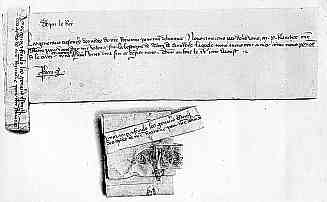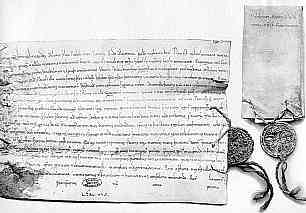


If you are looking at this page without frames, there is more information about medieval writing to be found by going to the home page (framed) or the site map (no frames).
| Letters Close | |||
| The term letters close essentially refers to letters which were closed. That is, unlike letters patent which were delivered open with the seal appended and treated as a public document, they were folded and the seal was used for the purpose of actually sealing up the letter. This means that the seal has a somewhat different function. Because it is destroyed when the letter is opened, it serves as testimony that the letter has not been tampered with. However, being destroyed, it cannot serve to ratify the document in the long term. Fundamentally, the term letters close refers to letters more or less as we know them. | |||
 |
Two views of a letter close of Jean le Bon, of 1362, showing the letter opened for reading, and folded for delivery (Arch. Nat. J 641 no 13/6). (From De Boüard 1929) | ||
| The above example is of a French royal letter close. The seal, naturally, is broken as it has been opened. The address is on a strip of parchment which is wrapped around the document and visible when the letter is folded. | |||
 |
Letter close of Pope Clement III, of 1188, also shown in two views; open for reading, and folded as it would have been for delivery (Arch. Nat. S 234 no 4). (From De Boüard 1929) | ||
| The papal letter close above has the leaden papal bulla attached with coarse hemp cords, rather than the finer silk cords used for higher grades of document. The cords have been threaded through holes in the parchment to keep the letter folded. The address is written on the dorso of the document, so as to be able to be read when it is folded. | |||
| According to Clanchy (Clanchy 1993) the earliest surviving example of an English royal letter close, which has not been opened and which has the seal intact, is from the reign of Henry VIII. This is not entirely astonishing as I guess if you got one of those things from the king you would open it. In fact, I wonder who would have been so remiss as to get one from Henry VIII and not open it. I guess we shall never know, because if it was opened it would not be the only surviving intact example. If one was of a philosophical, not to say quantum mechanical, bent one might regard it as a sort of Schrodinger's cat conundrum, but enough of that. |
 |
||
| Henry VIII, on discovering that one of his subjects has not opened his mail. | |||
| The term letters close can be used in a generalised sense for letters from anyone; kings, bishops, barons or somebody's grandmother, if they conform to the type as described. Most are lost to history along with loads of other dispersed documents that did not require archiving. In the English royal chancery they fit into the hierarchy of documents generated by the developing bureaucracy. From around 1200 copies of letters close were transcribed on to the Close Rolls, of which thousands survive. Diligent scholars of the past have provided transcripts and extracts in printed form, over 60 volumes of them. | |||
| It is possible to get entangled in terminology again, but here we go. The original writs or charters of Edward the Confessor could be regarded as a form of letters close, in that they were supposedly delivered wrapped up with the seal hanging down. However, these were a form of public document. The term is more usually applied to documents that were not designed for public proclamation, addressed to individuals. In some cases these could be writs in the later medieval sense of the word. The matters covered by such correspondence could be many and varied. | |||
|
|
|||
|
If you are looking at this page without frames, there is more information about medieval writing to be found by going to the home page (framed) or the site map (no frames). |
|||